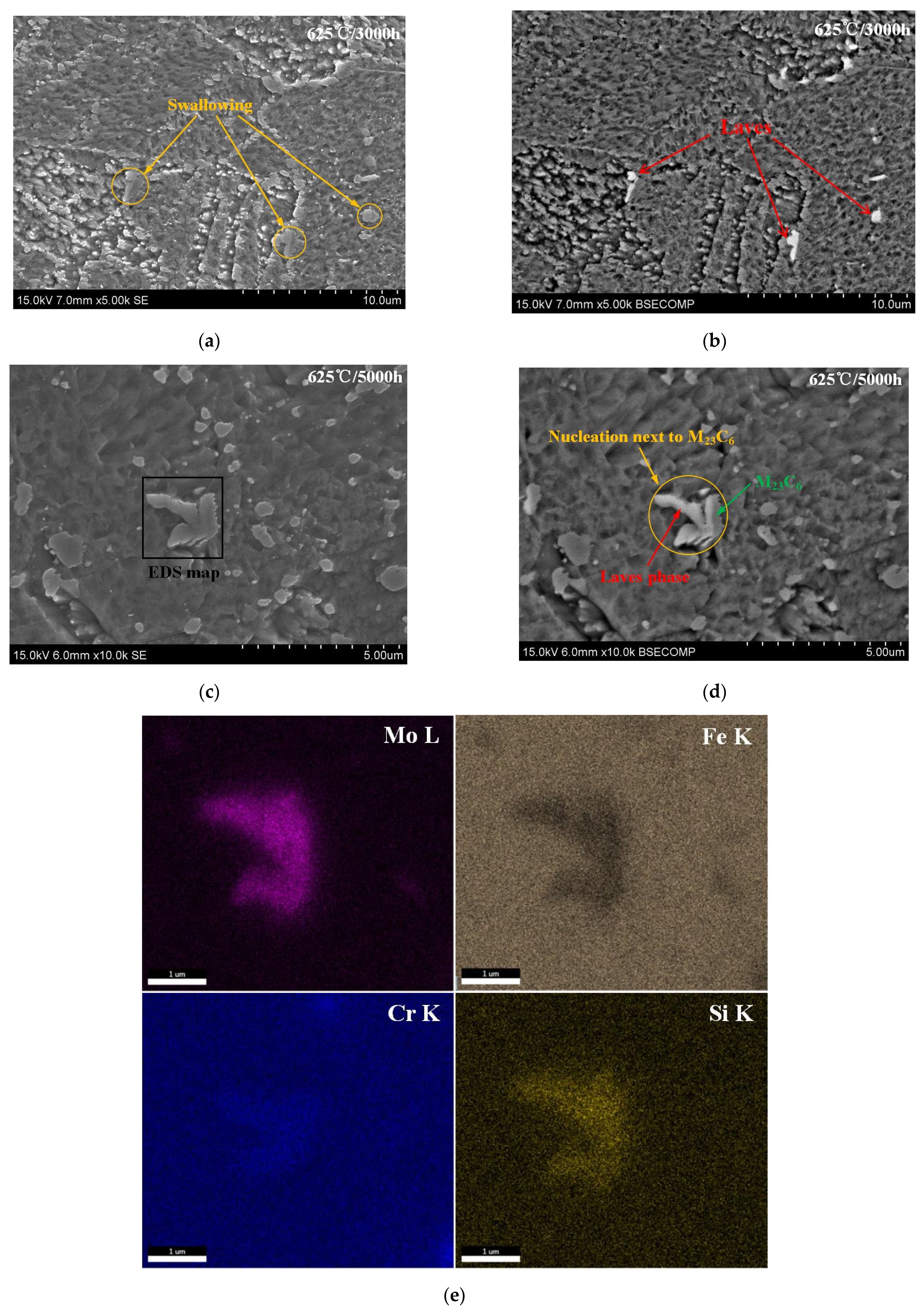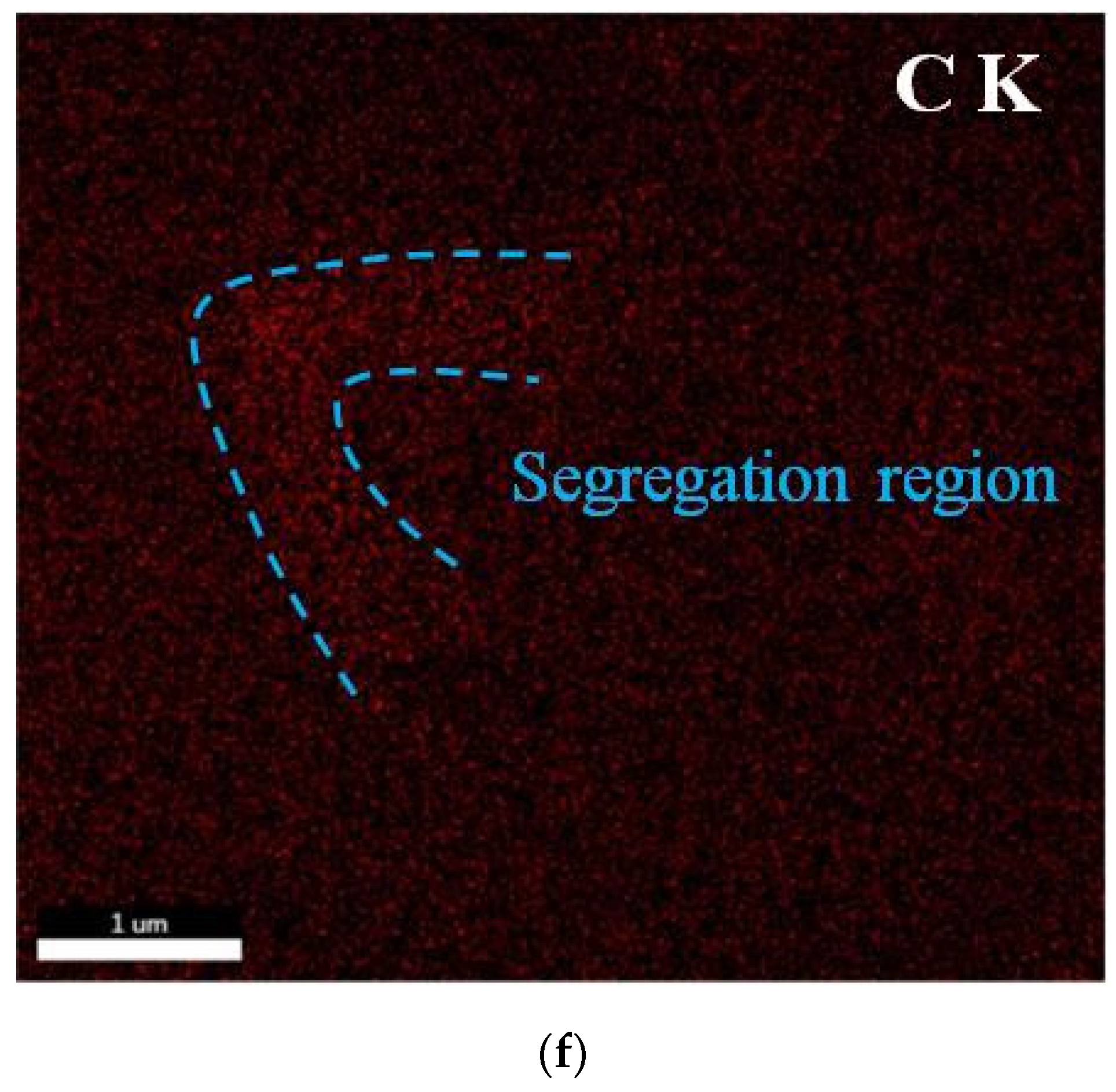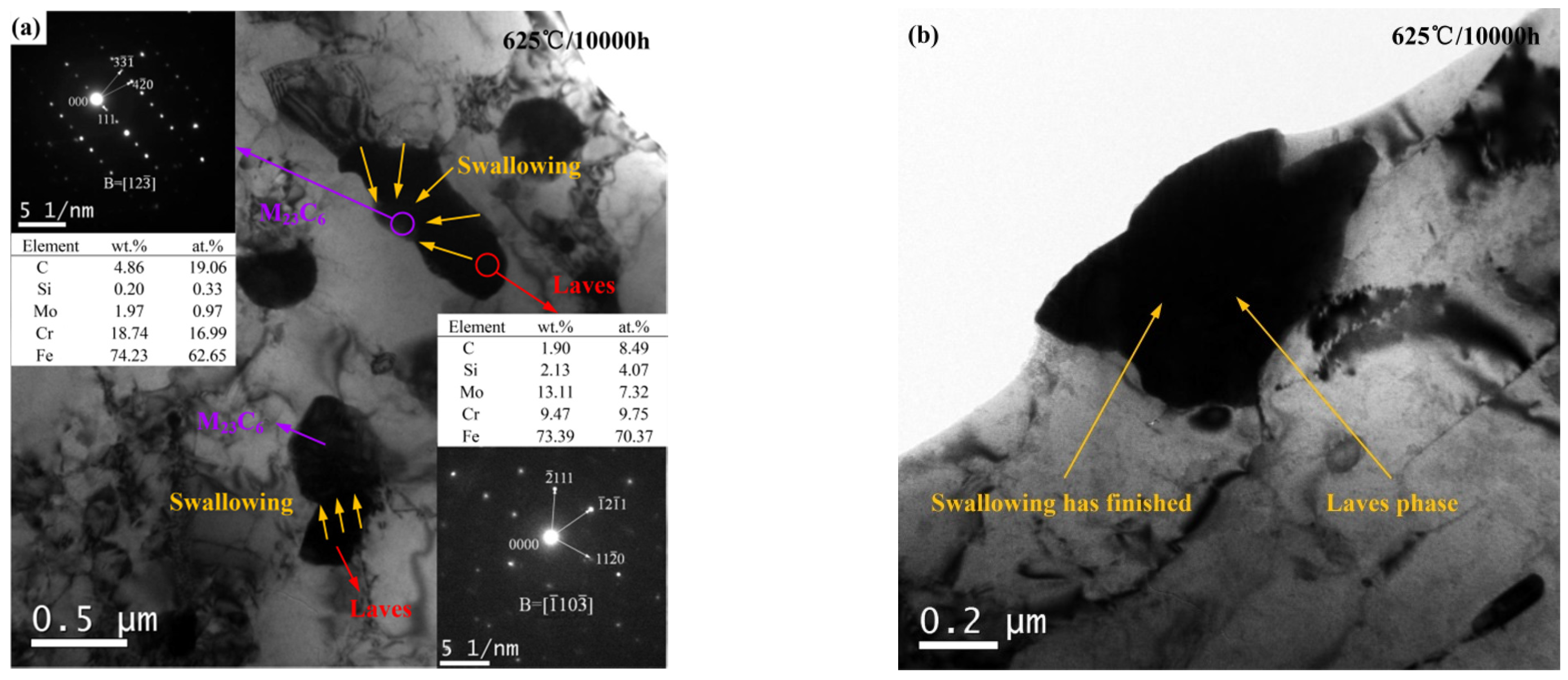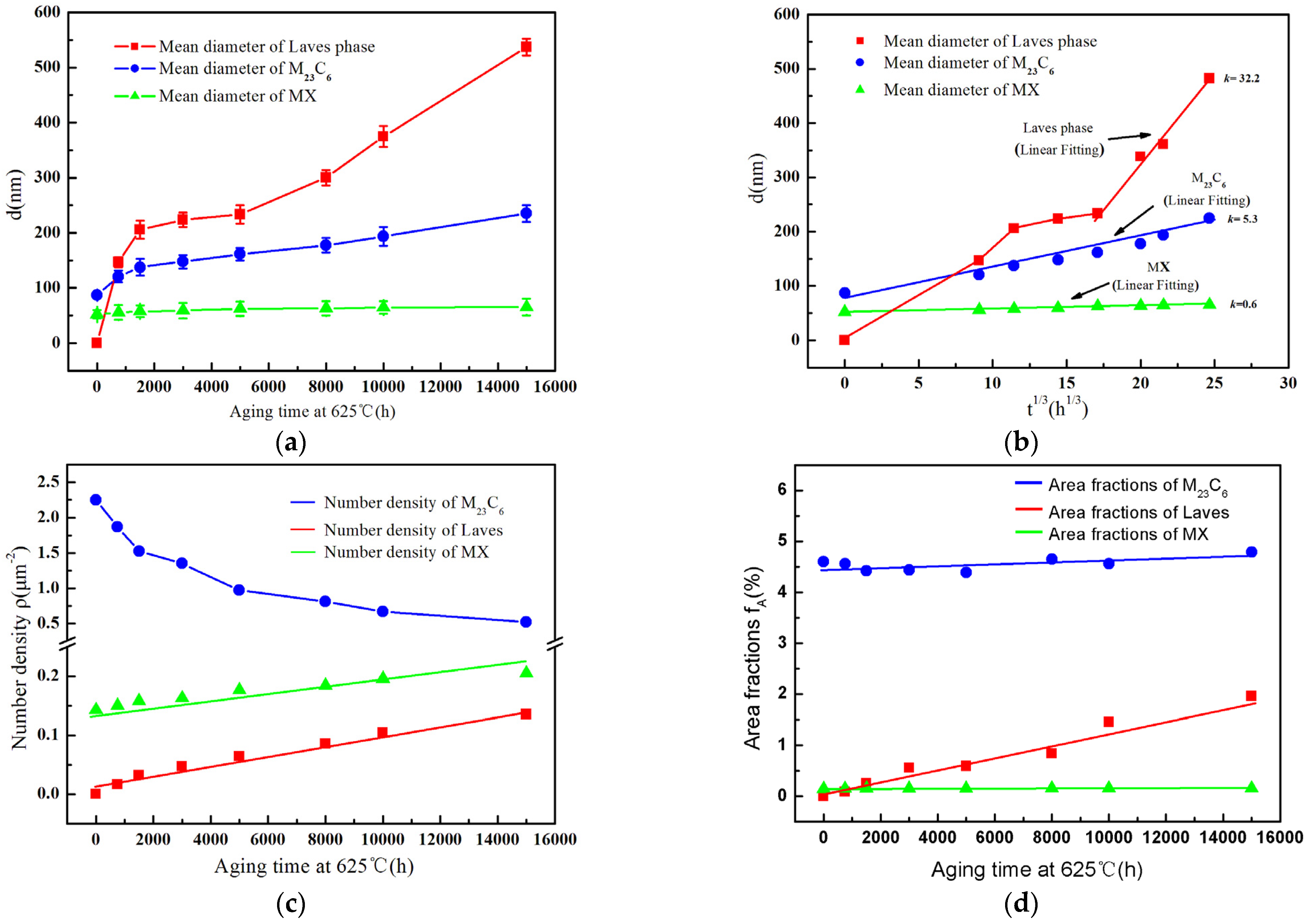Effect of Long-Term Aging on the Microstructural Evolution in a P91 Steel
Abstract
1. Introduction
2. Materials and Methods
3. Results and Discussion
3.1. Precipitation Behavior for Laves Phase, M23C6 Carbides and MX Carbonitrides at Different Aging Times
3.2. The Coarsening Behaviors of Laves Phase, M23C6 and MX
3.3. Orientation Relationships between Laves Phase and M23C6
4. Conclusions
- 1
- Laves phase, after long-term aging (>1500 h) at 625 °C, grew rapidly once precipitated. In addition, some Laves phases are formed in the regions adjacent to M23C6 particles.
- 2
- A new crystallographic orientation relationship between M23C6 carbides and Laves phase has been observed at 625 °C for 5000 h, the new orientation relationship is{0001}Laves∥{111}M23C6, <111>Laves∥ <011>M23C6.
- 3
- The coarsening behavior of the Laves phase is mainly affected by the phagocytic growth mechanism before 5000 h. The large irregular Laves phase precipitated at grain boundary or phase boundary will become an effective crack source, which will reduce rupture life of heat-resistant steel.
- 4
- The coarsening behaviors of Laves phase (more than 5000 h), M23C6 carbides and MX carbonitrides have been investigated, which confirms the existing ripening model of multicomponent alloys. The coarsening rates for the Laves phase, M23C6 and MX have values of about 32.2 (≥5000 h), 5.3 and 0.6 nm/h1/3, respectively.
Author Contributions
Funding
Institutional Review Board Statement
Informed Consent Statement
Data Availability Statement
Acknowledgments
Conflicts of Interest
References
- Otto, F.; Dlouhý, A.; Somsen, C.; Bei, H.; Eggeler, G.; George, E.P. The influences of temperature and microstructure on the tensile properties of a CoCrFeMnNi high-entropy alloy. Acta Mater. 2013, 61, 5743–5755. [Google Scholar] [CrossRef]
- Peansukmanee, S.; Phung-on, I.; Poopat, B.; Pearce, J.T.H.; Tsuda, K.; Nusen, S.; Chairuangsri, T. Study of the microstructure of the Grade 91 steel after more than 100,000 h of creep exposure at 600 °C—ScienceDirect. Int. J. Press. Vessel. Pip. 2010, 87, 326–335. [Google Scholar]
- Cerjak, H.; Hofer, P.; Schaffernak, B. The Influence of Microstructural Aspects on the Service Behaviour of Advanced Power Plant Steels. ISIJ Int. 1999, 39, 874–888. [Google Scholar] [CrossRef]
- Prat, O.; Garcia, J.; Rojas, D.; Carrasco, C.; Inden, G. Investigations on the growth kinetics of Laves phase precipitates in 12% Cr creep-resistant steels: Experimental and DICTRA calculations. Acta Mater. 2010, 58, 6142–6153. [Google Scholar] [CrossRef]
- Qiang, L. Precipitation of Fe 2 W laves phase and modeling of its direct influence on the strength of a 12Cr2W steel. Metall. Mater. Trans. A 2006, 37, 89–97. [Google Scholar]
- Cui, H.; Sun, F.; Chen, K.; Zhang, L.; Wan, R.; Shan, A.; Wu, J. Precipitation behavior of Laves phase in 10% Cr steel X12CrMoWVNbN10-1-1 during short-term creep exposure. Mater. Sci. Eng. A 2010, 527, 7505–7509. [Google Scholar] [CrossRef]
- Xu, Y.; Wang, M.; Wang, Y.; Gu, T.; Chen, L.; Zhou, X.; Ma, Q.; Liu, Y.; Huang, J. Study on the nucleation and growth of Laves phase in a 10% Cr martensite ferritic steel after long-term aging. J. Alloys Compd. 2015, 621, 93–98. [Google Scholar] [CrossRef]
- Hofer, P.; Cerjak, H.; Schaffernak, B.; Warbichler, P. Quantification of precipitates in advanced creep resistant 9–12% Cr steels. Steel Res. Int. 1998, 69, 343–348. [Google Scholar] [CrossRef]
- Abe, F.; Araki, H.; Noda, T. The effect of tungsten on dislocation recovery and precipitation behavior of low-activation martensitic 9Cr steels. Metall. Trans. A 1991, 22, 2225–2235. [Google Scholar] [CrossRef]
- Kostka, A.; Tak, K.-G.; Hellmig, R.J.; Estrin, Y.; Eggeler, G. On the contribution of carbides and micrograin boundaries to the creep strength of tempered martensite ferritic steels. Acta Mater. 2007, 55, 539–550. [Google Scholar] [CrossRef]
- Abe, F. Effect of quenching, tempering, and cold rolling on creep deformation behavior of a tempered martensitic 9Cr1W steel. Metall. Mater. Trans. A 2003, 34, 913–925. [Google Scholar] [CrossRef]
- Xu, Y.; Zhang, X.; Tian, Y.; Chen, C.; Nan, Y.; He, H.; Wang, M. Study on the nucleation and growth of M23C6 carbides in a 10% Cr martensite ferritic steel after long-term aging. Mater. Charact. 2016, 111, 122–127. [Google Scholar] [CrossRef]
- Lee, J.S.; Armaki, H.G.; Maruyama, K.; Muraki, T.; Asahi, H. Causes of breakdown of creep strength in 9Cr–1.8W–0.5Mo–VNb steel. Mater. Sci. Eng. A 2006, 428, 270–275. [Google Scholar] [CrossRef]
- Miyahara, K.; Hwang, J.; Shimoide, Y. Aging phenomena before the precipitation of the bulky laves phase in Fe-10%Cr ferritic alloys. Scr. Metall. Mater. 1995, 32, 1917–1921. [Google Scholar] [CrossRef]
- John, H. Metallurgy and creep properties of new 9-12%Cr steels. Steel Res. 1996, 67, 369–374. [Google Scholar]
- Yamamoto, K.; Kimura, Y.; Mishima, Y. Precipitation of the Icosahedral Quasicrystalline Phase, R-phase and Laves Phase in Ferritic Alloys. Trans. Mater. Heat Treat. 2004, 25, 229–233. [Google Scholar] [CrossRef][Green Version]
- Goldstein, J.I.; Newbury, D.E.; Echlin, P.; Joy, D.C.; Romig, A.D., Jr.; Lyman, C.E.; Fiori, C.; Lifshin, E. Scanning Electron Microscopy and X-ray Microanalysis. In A Text for Biologists, Materials Scientists, and Geologists; Plenum Press: New York, NY, USA; London, UK, 1992. [Google Scholar]
- Reuter, W. The ionization function and its application to the electron probe analysis of thin films. In Proceedings of the sixth International Conference on X-ray Optics and Microanalysis; University of Tokyo Press: Tokyo, Japan, 1972; pp. 121–137. [Google Scholar]
- Isik, M.I.; Kostka, A.; Eggeler, G. On the nucleation of Laves phase particles during high-temperature exposure and creep of tempered martensite ferritic steels. Acta Mater. 2014, 81, 230–240. [Google Scholar] [CrossRef]
- Isik, M.I.; Kostka, A.; Yardley, V.A.; Pradeep, K.G.; Duarte, M.J.; Choi, P.P.; Raabe, D.; Eggeler, G. The nucleation of Mo-rich Laves phase particles adjacent to M23C6 micrograin boundary carbides in 12% Cr tempered martensite ferritic steels. Acta Mater. 2015, 90, 94–104. [Google Scholar] [CrossRef]
- Hald, J.; Korcakova, L. Precipitate Stability in Creep Resistant Ferritic Steels-Experimental Investigations and Modelling. Trans. Iron Steel Inst. Jpn. 2003, 43, 420–427. [Google Scholar] [CrossRef]
- Sun, Z.; Song, G.; Ilavsky, J.; Ghosh, G.; Liaw, P.K. Nano-sized precipitate stability and its controlling factors in a NiAl-strengthened ferritic alloy. Sci. Rep. 2015, 5, 16081. [Google Scholar] [CrossRef]
- Philippe, T.; Voorhees, P.W. Ostwald ripening in multicomponent alloys. Acta Mater. 2013, 61, 4237–4244. [Google Scholar] [CrossRef]
- Voorhees, P.W. The theory of Ostwald ripening. J. Stat. Phys. 1985, 38, 231–252. [Google Scholar] [CrossRef]
- Eggeler, A. On the effect of long-term creep on the microstructure of a 12% chromium tempered martensite ferritic steel. Acta Mater. 2009, 57, 5093–5106. [Google Scholar]
- Xu, Y.; Nie, Y.; Wang, M.; Li, W.; Jin, X. The effect of microstructure evolution on the mechanical properties of martensite ferritic steel during long-term aging. Acta Mater. 2017, 131, 110–122. [Google Scholar] [CrossRef]






| Element | C | Si | Mn | P | S | Cr | Ni | Mo | V | Nb | N | Fe |
|---|---|---|---|---|---|---|---|---|---|---|---|---|
| wt.% | 0.10 | 0.30 | 0.5 | 0.017 | 0.003 | 9.0 | 0.7 | 1.0 | 0.20 | 0.06 | 0.04 | Bal. |
Publisher’s Note: MDPI stays neutral with regard to jurisdictional claims in published maps and institutional affiliations. |
© 2022 by the authors. Licensee MDPI, Basel, Switzerland. This article is an open access article distributed under the terms and conditions of the Creative Commons Attribution (CC BY) license (https://creativecommons.org/licenses/by/4.0/).
Share and Cite
Zhao, H.; Wang, Z.; Han, X.; Wang, M. Effect of Long-Term Aging on the Microstructural Evolution in a P91 Steel. Materials 2022, 15, 2847. https://doi.org/10.3390/ma15082847
Zhao H, Wang Z, Han X, Wang M. Effect of Long-Term Aging on the Microstructural Evolution in a P91 Steel. Materials. 2022; 15(8):2847. https://doi.org/10.3390/ma15082847
Chicago/Turabian StyleZhao, Hongchang, Zixi Wang, Xi Han, and Mingjia Wang. 2022. "Effect of Long-Term Aging on the Microstructural Evolution in a P91 Steel" Materials 15, no. 8: 2847. https://doi.org/10.3390/ma15082847
APA StyleZhao, H., Wang, Z., Han, X., & Wang, M. (2022). Effect of Long-Term Aging on the Microstructural Evolution in a P91 Steel. Materials, 15(8), 2847. https://doi.org/10.3390/ma15082847






